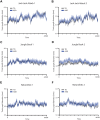This is a preprint.
Idiosyncratic pupil regulation in autistic children
- PMID: 38260528
- PMCID: PMC10802609
- DOI: 10.1101/2024.01.10.575072
Idiosyncratic pupil regulation in autistic children
Update in
-
Idiosyncratic pupil regulation in autistic children.Autism Res. 2024 Dec;17(12):2503-2513. doi: 10.1002/aur.3234. Epub 2024 Oct 10. Autism Res. 2024. PMID: 39385709 Free PMC article.
Abstract
Recent neuroimaging and eye tracking studies have suggested that children with autism spectrum disorder (ASD) may exhibit more variable and idiosyncratic brain responses and eye movements than typically developing (TD) children. Here we extended this research for the first time to pupillometry recordings. We successfully completed pupillometry recordings with 103 children (66 with ASD), 4.5-years-old on average, who viewed three 90 second movies, twice. We extracted their pupillary time-course for each movie, capturing their stimulus evoked pupillary responses. We then computed the correlation between the time-course of each child and those of all others in their group. This yielded an average inter-subject correlation value per child, representing how similar their pupillary responses were to all others in their group. ASD participants exhibited significantly weaker inter-subject correlations than TD participants, reliably across all three movies. Differences across groups were largest in responses to a naturalistic movie containing footage of a social interaction between two TD children. This measure enabled classification of ASD and TD children with a sensitivity of 0.82 and specificity of 0.73 when trained and tested on independent datasets. Using the largest ASD pupillometry dataset to date, we demonstrate the utility of a new technique for measuring the idiosyncrasy of pupil regulation, which can be completed even by young children with co-occurring intellectual disability. These findings reveal that a considerable subgroup of ASD children have significantly more unstable, idiosyncratic pupil regulation than TD children, indicative of more variable, weakly regulated, underlying neural activity.
Conflict of interest statement
Conflict of Interest Statement: Behrmann is a founder of Precision Neuroscopics, a company developing medical technologies with a focus on equity and inclusion in healthcare. All other authors declare no competing financial interests.
Figures





References
-
- de Vries L, Fouquaet I, Boets B, Naulaers G, Steyaert J (2021): Autism spectrum disorder and pupillometry: A systematic review and meta-analysis. Neurosci Biobehav Rev 120: 479–508. - PubMed
-
- Belliveau AP, Somani AN, Dossani RH (2023): Pupillary Light Reflex. StatPearls. Retrieved September 10, 2023, from https://www.ncbi.nlm.nih.gov/books/NBK537180/ - PubMed
-
- Aston-Jones G, Cohen JD (2005): An integrative theory of locus coeruleus-norepinephrine function: adaptive gain and optimal performance. Annu Rev Neurosci 28: 403–450. - PubMed
Publication types
Grants and funding
LinkOut - more resources
Full Text Sources
